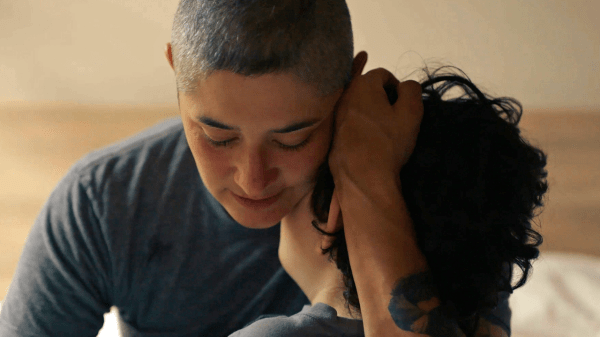
“Our desire for viewers to see Moses as a full-spectrum human with the capacity to feel both joy and pain guided our lens and the footage we included,” the director Rivkah Beth Medow said.
The short documentary “Holding Moses,” directed by Rivkah Beth Medow and Jen Rainin, can be understood as a story about a mother bearing a difficult burden, a story of how becoming the parent of a disabled son stretches one caregiver beyond what she thought she could endure. It can also be understood through the lens of disability rhetoric as a film that both engages with and resists myths about disability.
Randi Rader always wanted to have children. Moses was conceived the (somewhat) old-fashioned way: “The midwife came over and turkey-baster-style pushed some sperm into me, and I got pregnant the very first time,” Rader says. When Moses was born, he could barely move or cry, and for a long time he did not open his eyes. He was diagnosed with a rare genetic disorder that makes it difficult to walk and talk and often causes developmental delays.
The New Yorker Documentary
View the latest or submit your own film.

It’s taboo for mothers to express ambivalence about parenthood, and even more so for caregivers of children with limitations. The subject and director of “Holding Moses” intentionally confront that taboo. Rader describes with raw emotion the years she spent privately mourning the child she thought she would have, and the loss of her independence.
She and Rader screened the film for people and organizations in the queer, disabled, and caretaker communities. The response, Medow said, had been generally one of relief and validation. Caregivers are a “deeply invisible community,” she explained, and sharing complicated feelings about caregiving can feel like “taking up space” in a way that feels “selfish, inappropriate, or unacceptable.”
We can’t hear from young Moses himself, but throughout the film we see him lovingly entangled in a nurturing network. “Our desire for viewers to see Moses as a full-spectrum human with the capacity to feel both joy and pain guided our lens and the footage we included,” Medow said. “It was critical for us to avoid using our lens to highlight the traumas around Moses’s care.” We see Rader injecting water in his G tube, cleaning his teeth, placing a hand on his forehead to check for overheating—these medical actions are only one part of a larger exchange of care. Moses places his hands on his mother’s face, sometimes smacking it lightly if he’s frustrated; she gently redirects him. The film is characterized by a velvety softness seen through cheeks smushed together, palms pressed, Moses’s light tread on the wood floors at home. The warm domestic setting helps us see Moses’s experience as part of the shared life of a family, a framing that is often missing from disability narratives.
The family depicted here is deeply loving and “deeply queer,” as Medow put it. “Randi is visually striking and, because she presents as very masculine of center, defies most people’s image of a mother.” Rader is a dancer and performer who has been a member of the percussive dance troupe STOMP. The film juxtaposes her able body with Moses’s disabled one, with the seeming intent of making viewers uncomfortable: where Rader slings a bike over her shoulder and hikes up a mountain, Moses struggles to get out of bed. Rader describes finding relief from grief in working with a physically demanding dance collective. Beyond exhaustion, she found that she had more to give. Or is it simply that she had to give more? Dance here is both language and salve. Toward the end of the film, we see the family—Rader, Moses, and his two sisters—on a walk outside. The youngest girl falls. “Oh,” Rader says. “You just landed right on the hard thing.” The girl struggles back up, looking seriously down at her dusty clothes. Rader takes her and Moses by the hand, moving them in a gentle rhythm. “All right,” Rader says. “Dance it out. Dance it out.”
The film intercuts Rader’s voice-over narration with shots of her physical actions, so expressive they serve as commentary, a vocabulary of feet like dry leaves sliding across the wooden planks of a patio, a pinky finger extended, as though for a child to suck. Moses’s body is expressive in other ways. The shapes he makes with his body are eloquent, a lanky splash of sleepiness, a stiff-necked resistance to being fed, the way he folds himself into Rader’s body, as though completing a sentence.
If we live long enough, all of us will become disabled in some way. But, despite this inevitability, a disabled person can too easily be made into a rhetorical object, a screen on which our culture projects its fears and desires. This, in many ways, is the central question of the film: How can one move away from viewing disability as something other, and enter into a profound communication with it?
This piece has been updated to clarify a quote from the film.
Sourse: newyorker.com






